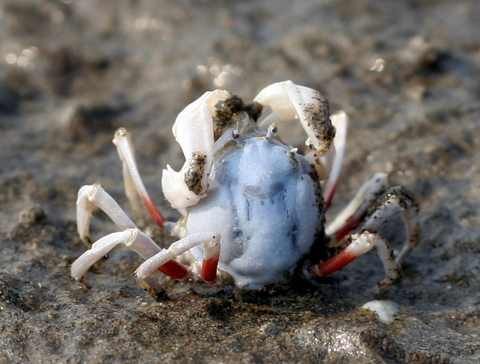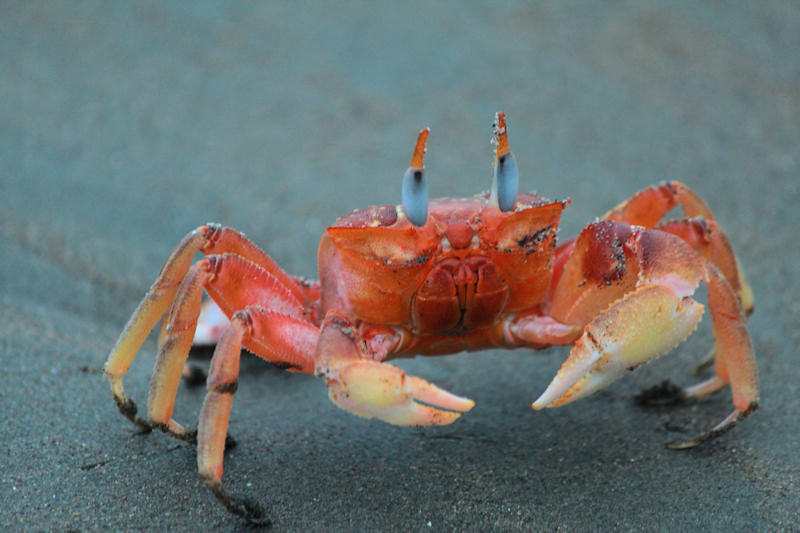|
Ocypodoidea
The Ocypodoidea, or ocypoid crabs, are a superfamily of crab Crabs are decapod crustaceans of the infraorder Brachyura, which typically have a very short projecting "tail" (abdomen) ( el, βραχύς , translit=brachys = short, / = tail), usually hidden entirely under the thorax. They live in all the ...s, named after the genus '' Ocypode''. It contains over 300 extant species in these eight families: * Camptandriidae Stimpson, 1858 * Dotillidae Stimpson, 1858 * Heloeciidae H. Milne-Edwards, 1852 * Macrophthalmidae Dana, 1851 * Mictyridae Dana, 1851 * Ocypodidae Rafinesque, 1815 * Ucididae Števčić, 2005 * Xenophthalmidae Stimpson, 1858 References Crabs Taxa named by Constantine Samuel Rafinesque Arthropod superfamilies {{crab-stub ... [...More Info...] [...Related Items...] OR: [Wikipedia] [Google] [Baidu] |
Ocypodoidea
The Ocypodoidea, or ocypoid crabs, are a superfamily of crab Crabs are decapod crustaceans of the infraorder Brachyura, which typically have a very short projecting "tail" (abdomen) ( el, βραχύς , translit=brachys = short, / = tail), usually hidden entirely under the thorax. They live in all the ...s, named after the genus '' Ocypode''. It contains over 300 extant species in these eight families: * Camptandriidae Stimpson, 1858 * Dotillidae Stimpson, 1858 * Heloeciidae H. Milne-Edwards, 1852 * Macrophthalmidae Dana, 1851 * Mictyridae Dana, 1851 * Ocypodidae Rafinesque, 1815 * Ucididae Števčić, 2005 * Xenophthalmidae Stimpson, 1858 References Crabs Taxa named by Constantine Samuel Rafinesque Arthropod superfamilies {{crab-stub ... [...More Info...] [...Related Items...] OR: [Wikipedia] [Google] [Baidu] |
Heloeciidae
''Heloecius cordiformis'' is a species of semiterrestrial crab found in mangrove swamps and mudflats along the east coast of Australia. Adults are around wide, with males being larger and having larger and more conspicuously coloured claws. The males wave their claws to communicate with other crabs, giving them their common name of semaphore crab. They can breathe both in air and under water, and feed at low tide on detritus in the sediment. ''H. cordiformis'' is the only species in the genus ''Heloecius'' and the family Heloeciidae. Description Adults of ''H. cordiformis'' are around wide, with a dark purple, mottled carapace. The compound eyes are on long eyestalks. The claws are sexually dimorphic, with males' claws showing positive allometry, while females' claws grow isometrically; a male's claws thus become proportionally larger as the crab grows, becoming much larger than those of females. The colour of the claws is correlated with both sex and size. The smallest c ... [...More Info...] [...Related Items...] OR: [Wikipedia] [Google] [Baidu] |
Crabs
Crabs are decapod crustaceans of the infraorder Brachyura, which typically have a very short projecting "tail" (abdomen) ( el, βραχύς , translit=brachys = short, / = tail), usually hidden entirely under the thorax. They live in all the world's oceans, in freshwater, and on land, are generally covered with a thick exoskeleton, and have a single pair of pincers. They first appeared during the Jurassic Period. Description Crabs are generally covered with a thick exoskeleton, composed primarily of highly mineralized chitin, and armed with a pair of chelae (claws). Crabs vary in size from the pea crab, a few millimeters wide, to the Japanese spider crab, with a leg span up to . Several other groups of crustaceans with similar appearances – such as king crabs and porcelain crabs – are not true crabs, but have evolved features similar to true crabs through a process known as carcinisation. Environment Crabs are found in all of the world's oceans, as well as in fresh w ... [...More Info...] [...Related Items...] OR: [Wikipedia] [Google] [Baidu] |
Crab
Crabs are decapod crustaceans of the infraorder Brachyura, which typically have a very short projecting "tail" (abdomen) ( el, βραχύς , translit=brachys = short, / = tail), usually hidden entirely under the thorax. They live in all the world's oceans, in freshwater, and on land, are generally covered with a thick exoskeleton, and have a single pair of pincers. They first appeared during the Jurassic Period. Description Crabs are generally covered with a thick exoskeleton, composed primarily of highly mineralized chitin, and armed with a pair of chelae (claws). Crabs vary in size from the pea crab, a few millimeters wide, to the Japanese spider crab, with a leg span up to . Several other groups of crustaceans with similar appearances – such as king crabs and porcelain crabs – are not true crabs, but have evolved features similar to true crabs through a process known as carcinisation. Environment Crabs are found in all of the world's oceans, as well as in ... [...More Info...] [...Related Items...] OR: [Wikipedia] [Google] [Baidu] |
Ucididae
''Ucides'' is a genus of mangrove crabs in the monotypic family Ucididae, containing two species: * ''Ucides cordatus'' (Linnaeus, 1763) – Atlantic coast from Florida to Uruguay * ''Ucides occidentalis ''Ucides'' is a genus of mangrove crabs in the monotypic family Ucididae, containing two species: * ''Ucides cordatus'' (Linnaeus, 1763 Events January–March * January 27 – The seat of colonial administration in the Vicer ...'' ( Ortmann, 1897) – Pacific coast from Mexico to Peru References External links * Ocypodoidea Taxa named by Mary J. Rathbun {{crab-stub ... [...More Info...] [...Related Items...] OR: [Wikipedia] [Google] [Baidu] |
Ocypodidae
The Ocypodidae are a family of semiterrestrial crabs that includes the ghost crabs and fiddler crabs. They are found on tropical and temperate shorelines around the world. Some genera previously included in the family are now treated as members of separate families in the superfamily Ocypodoidea, such as the Dotillidae and Macrophthalmidae. In 2016, the genus Uca was split into 13 genera by elevating its subgenera to genus rank, among other things. Further refinements have been made to the organization of the family, which has 4 subfamilies, about 13 extant genera, and about 180 described species as of 2020. The majority of the Ocypodidae species are fiddler crabs, the exceptions being the members of the genus '' Ocypode'', ghost crabs, and the genus '' Ucides'', mangrove crabs. Genera These genera belong to the family Ocypodidae: * '' Afruca'' Crane, 1975 * '' Austruca'' Bott, 1973 * '' Cranuca'' Beinlich & von Hagen, 2006 * '' Gelasimus'' Stimpson 1862 * '' Leptuca'' Bott, ... [...More Info...] [...Related Items...] OR: [Wikipedia] [Google] [Baidu] |
Macrophthalmidae
The Macrophthalmidae are a family of crab Crabs are decapod crustaceans of the infraorder Brachyura, which typically have a very short projecting "tail" (abdomen) ( el, βραχύς , translit=brachys = short, / = tail), usually hidden entirely under the thorax. They live in all the ...s, comprising these subfamilies and genera: ;Ilyograpsinae Števčić, 2005 *'' Apograpsus'' Komai & Wada, 2008 *'' Ilyograpsus'' Barnard, 1955 ;Macrophthalminae Dana, 1851 *'' Australoplax'' Barnes, 1966 *'' Enigmaplax'' Davie, 1993 *'' Hemiplax'' Heller, 1865 *'' Lutogemma'' Davie, 2008 *'' Macrophthalmus'' Desmarest, 1823 *'' Tasmanoplax'' Barnes, 1967 *'' Venitus'' Barnes, 1967 ;Tritodynamiinae Števčić, 2005 *'' Tritodynamia'' Ortmann, 1894 References Ocypodoidea Decapod families {{crab-stub ... [...More Info...] [...Related Items...] OR: [Wikipedia] [Google] [Baidu] |
Mictyridae
''Mictyris'' is a genus of brightly coloured crabs, placed in its own taxonomical family, the Mictyridae. It inhabits the central Indo-West Pacific region. These crabs congregate on mud flats or beaches in groups of a few thousand, and filter sand or mud for microscopic organisms. They congregate during low tide, and bury themselves in the sand during high tide or whenever they are threatened. This is done in wet sand, and they dig in a corkscrew A corkscrew is a tool for drawing corks from wine bottles and other household bottles that may be sealed with corks. In its traditional form, a corkscrew simply consists of a pointed metallic helix (often called the "worm") attached to a hand ... pattern, leaving many small round pellets of sand behind them. Species The genus contains eight species: The predictable behaviour of these crabs has led them to be used in experiments in a form of billiard ball computer. References External links * Ocypodoidea {{Crab-stub C ... [...More Info...] [...Related Items...] OR: [Wikipedia] [Google] [Baidu] |
Ocypode Cordimana
''Ocypode cordimanus'' is a species of crab in the family Ocypodidae, sometimes called the smooth-handed ghost crab. It is widely distributed in the Indian Ocean and Pacific Ocean The Pacific Ocean is the largest and deepest of Earth's five oceanic divisions. It extends from the Arctic Ocean in the north to the Southern Ocean (or, depending on definition, to Antarctica) in the south, and is bounded by the contin .... References External links * * Ocypodoidea Crustaceans described in 1818 {{crab-stub ... [...More Info...] [...Related Items...] OR: [Wikipedia] [Google] [Baidu] |
Dotillidae
The Dotillidae are a family of crabs with 59 species, nearly half of which are in the genus '' Ilyoplax''. The two genera ''Scopimera'' and ''Dotilla'' are collectively the sand bubbler crabs, which leave conspicuous collections of sand pellets on sandy beaches across the tropical and subtropical Indo-Pacific The Indo-Pacific is a vast biogeographic region of Earth. In a narrow sense, sometimes known as the Indo-West Pacific or Indo-Pacific Asia, it comprises the tropical waters of the Indian Ocean, the western and central Pacific Ocean, and the .... Genera Nine genera are currently recognised: *'' Dotilla'' Stimpson, 1858 *'' Dotilloplax'' Tweedie, 1950 *'' Dotillopsis'' Kemp, 1919 *'' Ilyoplax'' Stimpson, 1858 *'' Potamocypoda'' Tweedie, 1938 *'' Pseudogelasimus'' Tweedie, 1937 *'' Scopimera'' De Haan, 1835 *'' Shenius'' Serène, 1971 *'' Tmethypocoelis'' Koelbel, 1897 References Ocypodoidea Decapod families {{crab-stub ... [...More Info...] [...Related Items...] OR: [Wikipedia] [Google] [Baidu] |
Camptandriidae
The Camptandriidae are a family of crabs, with 38 species in 21 genera: *'' Baruna'' Stebbing, 1904 *'' Calabarium'' Manning & Holthuis, 1981 *'' Camptandrium'' Stimpson, 1858 *'' Cleistostoma'' De Haan, 1833 *'' Deiratonotus'' Manning & Holthuis, 1981 *'' Ecphantor'' Manning & Holthuis, 1981 *'' Ilyogynnis'' Manning & Holthuis, 1981 *'' Lillyanella'' Manning & Holthuis, 1981 *'' Manningis'' Al-Khayat & Jones, 1996 *''Moguai André Tegeler (born 9 August 1973), known by his stage name Moguai (stylised as MOGUAI), is a German music producer and DJ. In the early 1990s, he took the alias Moguai and began organising his own club nights and parties in Ruhrgebiet and M� ...'' C. G. S. Tan & Ng, 1999 *'' Mortensenella'' Rathbun, 1909 *'' Nanusia'' C. G. S. Tan & Ng, 1999 *'' Nasima'' Manning, 1991 *'' Paracleistostoma'' De Man, 1895 *'' Paratylodiplax'' Serène, 1974 *'' Serenella'' Manning & Holthuis, 1981 *'' Takedellus'' C. G. S. Tan & Ng, 1999 *'' Telmatothrix'' Manning & Holth ... [...More Info...] [...Related Items...] OR: [Wikipedia] [Google] [Baidu] |
Ghost Crab
Ghost crabs are semiterrestrial crabs of the subfamily Ocypodinae. They are common shore crabs in tropical and subtropical regions throughout the world, inhabiting deep burrows in the intertidal zone. They are generalist scavengers and predators of small animals. The name "ghost crab" derives from their nocturnality and their generally pale coloration. They are also sometimes called sand crabs, though the name refers to various other crabs that do not belong to the subfamily. Characteristics of the subfamily include one claw being larger than the other, thick and elongated eyestalks, and a box-like body. The differences in claw sizes, however, are not as marked as in male fiddler crabs. The subfamily includes 22 species in two genera. Taxonomy Ocypodinae is one of two subfamilies in the family Ocypodidae, the other being the fiddler crab subfamily, Ucinae. Both subfamilies have members in which one of the claw-bearing legs (the chelipeds) is much larger than the other. However ... [...More Info...] [...Related Items...] OR: [Wikipedia] [Google] [Baidu] |
.jpg)

